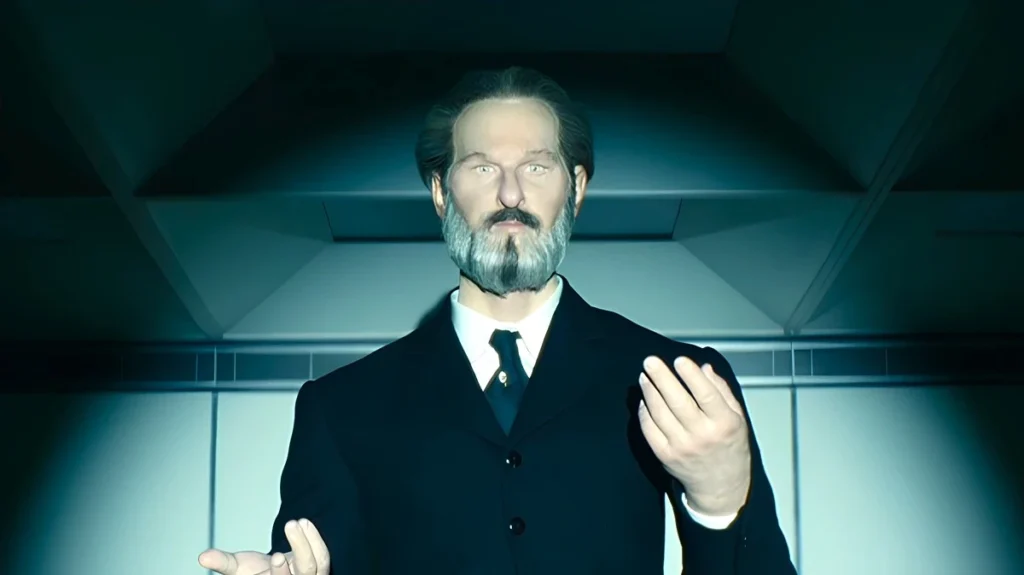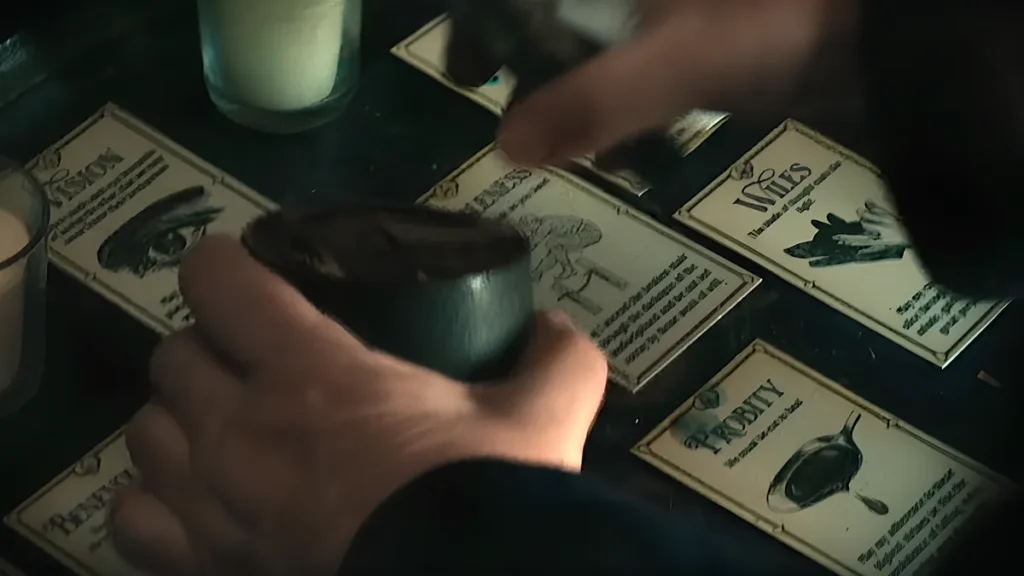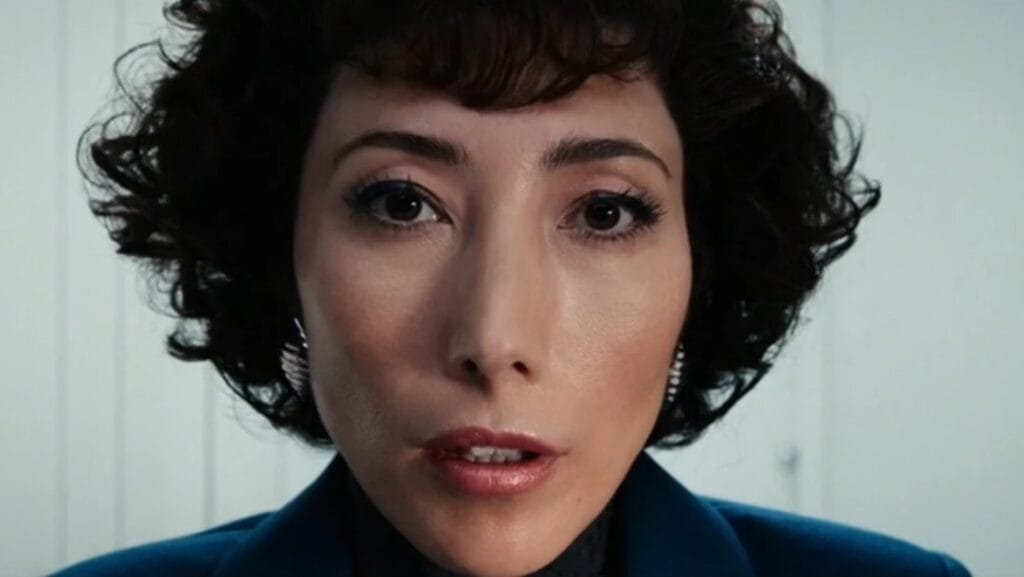What drives a company to create its own rituals, doctrines, and symbols, as if it were a secret religion? In Severance, Lumon hides more than corporate secrets: it operates as a complete belief system — with unquestionable values, near-liturgical practices, and a silent promise of redemption through obedience. Lumon mythology unfolds throughout the series, often through subtle details.
This article is a deeper dive following our previous post Lumon in Severance: the company that turned obedience into a cult
Just like religions and doctrines build mythologies through symbols, rituals, and narratives that sink into the collective unconscious, Lumon has developed its own symbolic system. With a near-sacred retro aesthetic, doctrinal slogans, and a founder revered as a prophet, the company doesn’t just manage workflows — it cultivates a model of faith.
Gradually, employees stop performing tasks and start believing in them. They repeat phrases like “the kindness of Kier” and celebrate events like Wintertide with genuine devotion. In this environment, productivity and submission go hand in hand.
More than a dystopian corporation, Lumon in Severance represents the transformation of ideological structures into corporate myths. Its symbolic system doesn’t aim to explain the world — it aims to numb it. And like any true mythology, its power doesn’t lie in facts, but in what followers are led to believe.
But what exactly makes up this mythology? How does it hold such power — even in the face of pain, doubt, and suffering? The answer may lie closer to religion than business. And that’s what we’ll explore as we unravel the enigmas of Lumon.
1. Kier Eagan as Founding and Messianic Entity

Every mythology needs a creator — and at Lumon, that role belongs to Kier Eagan, the company’s founder and cornerstone of its internal doctrine. Though he never appears directly in the show, his presence dominates every space. Portraits in the hallways, solemn phrases on the walls, and conduct manuals all reinforce his image as an omnipresent figure.
Kier isn’t merely remembered — he is venerated. His name is linked to absolute virtues: the “kindness of Kier,” “Eaganist values,” and his “eternal vision.” Employees sing songs in his honor, memorize his teachings, and attend events that exalt his legacy.
For instance, his birthday celebration serves as a ritual of devotion. Speeches, dances, and symbolic gestures turn the occasion into something far beyond a corporate formality — the atmosphere borders on the religious.
Thus, the founder ceases to be just a name on the org chart. Kier becomes a corporate prophet, a near-spiritual entity whose legacy serves as the moral foundation of the organization. Any dissent becomes heresy. Obedience becomes an act of faith.
Lumon doesn’t follow a traditional corporate model. It builds a myth. It turns its founder into dogma. After all, it’s much harder to abandon a belief than to quit a job.
2. The Nine Principles and the Fragmented Temperaments: morality and the diagnosis of the self




At Lumon, the Nine Principles function as commandments. Each one represents a virtue that every employee is expected to embody — such as cheer, wit, humility, and probity. These values are taught as absolute truths, and obedience to them defines how aligned someone is with the company.
The constant reinforcement of these principles serves two purposes: to impose a behavioral standard and to evaluate employees based on their compliance. Those who adapt easily are exalted. Those who resist — even in silence — end up marked by dissent.
But behind this rigid moral system, the series reveals a darker layer: a silent emotional diagnosis applied to employees. In the Cold Harbor project, we discover that the macrodata refinement process is used to shape internal versions of a person based on specific temperaments, such as woe, frolic, malice, and dread. The Waffle Party, initially introduced as a reward, is later revealed as a ritual that symbolizes these fragmented emotional states, performed by masked figures in a choreographed display.
In this way, the company combines rigid morality with subjective analysis to fully control those under its authority. It’s not enough to obey — one must appear pure.
3. Wintertide and Indoctrination from Childhood

Lumon mythology doesn’t begin in the company’s hallways — it starts before the first ID badge. In episode 2×08, we learn that Harmony Cobel was a recipient of the Wintertide program, a Lumon initiative targeting promising youth. Though it appears to be a prestigious scholarship, the Wintertide Fellowship is, in practice, a recruitment and indoctrination tool.
Harmony studied at Myrtle Eagan Girls School, founded by the company itself. The program included working in Lumon factories, like the ether plant in Salt’s Neck, where she and her friend Hampton worked during their youth. More than education, the goal seemed to be conditioning: exposing children to industrial environments and ideological discourse to ensure they would never question the system.
Her visit to her aunt, Celestine Cobel, reinforces this. Celestine was a matriarch of the doctrine, a former mentor to young Lumon trainees. Their conversation implies that this corporate faith wasn’t just inherited — it was cultivated over generations.

The doctrine also shapes the new generation. Assistant Ms. Huang, who appears in season two, is mentioned as part of the same program. In episode 6, Milchick says she’s not ready for Wintertide yet, suggesting her indoctrination is still under evaluation — as if Lumon molds future leaders based on faith and submission.
In Lumon mythology, education isn’t a right — it’s a stage in the cult.

4. The Aesthetic of Worship: Objects, Architecture, and Silence

Lumon doesn’t need to shout its doctrine — it etches it into space. White corridors, vintage furniture, outdated computers, and windowless rooms aren’t just aesthetic choices: they symbolize purity, control, and obedience. The architecture becomes an extension of the cult, where silence itself communicates reverence.
Every object holds symbolic meaning. The grotesque sculptures of the Four Humors, the framed Kier quotes, even the meticulously placed rugs — all contribute to a sacred visual language. Spaces don’t aim to comfort — they aim to shape the mind. Just like religions use symbols, temples, and robes to reinforce faith, Lumon builds a visual universe that turns routine into ritual.
This frozen-in-time aesthetic suggests that Lumon operates outside the normal world. It positions itself as eternal, immutable, beyond history. This heightens the feeling that employees don’t just work there — they live inside a belief system.
Behind the scenes, production designer Jeremy Hindle confirmed this effect was intentional. The team drew inspiration from modernist architects like Eero Saarinen and used buildings such as the Bell Labs Holmdel Complex in New Jersey to evoke a timeless space. The use of retro objects and neutral tones further reinforces the atmosphere of alienation and reverence.
In Lumon mythology, even silence is sacred.
5. The Break Room: confession as emotional indoctrination
The Break Room stands as one of Lumon’s most striking rituals. The series introduces this space in the first season, when Helly attempts to take her own life. As punishment, the company forces her to repeat guilt-ridden phrases hundreds of times, like a doctrinal mantra.
In this environment, however, the company demands more than simple obedience. The supervisor watches every detail: posture, tone of voice, and emotional delivery. When Helly reads the text for the first time, Milchick interrupts her — she doesn’t show genuine remorse. He then instructs her to repeat it until the guilt sounds real. And, more importantly, until she herself starts to believe it.
Therefore, the Break Room doesn’t accept hollow submission. Its true purpose is to emotionally condition the employee, shaping their mind through forced repetition. Pain and emotional exhaustion don’t happen by accident — they are part of the method. In this way, the company turns repentance into a tool of psychological control.
Furthermore, this ritual reveals an even more perverse logic: obeying is not enough. The employee must internalize the guilt as truth, until all resistance collapses under the weight of exhaustion. Suffering, once intimate, becomes fuel for corporate faith. Thus, even pain becomes useful within Lumon’s system.
6. The Waffle Party: A Ritual of Emotional Submission

The Waffle Party is one of Lumon’s most unusual rewards. At the end of the first season, Dylan receives the “prize” after breaking the refinement record. He begins by eating waffles alone in a room. Then, he’s taken to another space, where five masked figures perform a silent, ritualistic choreography — including one wearing the Kier Eagan mask.
In the second season, the final episode reveals a new meaning behind the ritual. Harmony Cobel explains that the macrodata refinement process, carried out by Mark, was part of the Cold Harbor project: he was unknowingly helping shape internal versions of Gemma, each based on a distinct temperament — such as woe, frolic, malice and dread. The scene intercuts these lines with images of the masked dancers, suggesting that each figure represents one of these emotional states (so far, this association applies only to Mark’s case; there’s no indication that the other innies are part of the same type of experiment).
The performance blends discomfort, eroticism, and reverence. Though presented as a reward, the experience reinforces emotional control. What should be a celebration turns into another test of submission.
In Lumon mythology, even pleasure follows a ritual.
The temperaments — affliction, frolic, malice — are core elements of the refinement process in the MDR.
Discover how they connect to the Cold Harbor experiment.
Uncover the true purpose of data refinement in Severance.
7. Gemma in Lumon Mythology: Submission, Loss, and Identity Rewriting

The connection between Ms. Casey and Gemma Scout — Mark’s wife, presumed dead in the outside world — is revealed to the audience in episode 1×07 of Severance, when the outer Mark pieces together a torn photo of his wife, and viewers, upon seeing the restored image, recognize the face of Ms. Casey.
The moment of greatest impact, however, comes at the end of the season, when the inner Mark sees the same photo and tells Devon: “She’s alive!”
Since then, fans have speculated whether Casey is a clone, a replica, or perhaps even the original Gemma, given that Mark firmly believed she was dead.
In episode 2×07, the mystery ends. We see Gemma’s routine as a test subject within Lumon, suggesting she is intermittently under the effects of severance. At times, she accesses her original memories, confirming she is not a copy — she is Gemma herself.
This revelation deepens the company’s mythology. Lumon doesn’t just separate memories — it hijacks real people and rewrites their stories. By keeping Gemma in a state of psychological control and emotional isolation, the company turns personal trauma into experimental material.
In Lumon’s mythological framework, death is not an end — it’s an opportunity to rewrite the self: no ties, no past, fully submissive.
8. Cold Harbor: Multiplying the Self as Corporate Doctrine
In season two, the show introduces Project Cold Harbor — a secret experiment testing the creation of multiple severed consciousnesses from a single individual. The subject is Gemma, who is subjected to emotionally traumatic situations under the effects of severance, such as dismantling a crib tied to the loss of her child.
Meanwhile, Jame Eagan and Dr. Mauer observe her, waiting for a cold, obedient reaction. In another scene, Cobel reveals that the experiment involved 25 distinct consciousnesses, all generated from Gemma.
We explore this moment in more detail in our review of episode 2×10,
where the Cold Harbor project and its implications take center stage: Severance 2×10 Review.
Beyond technological ambition, Cold Harbor represents the ultimate expression of Lumon’s doctrine: fragmenting the individual, erasing trauma, isolating emotion, and reshaping functional mental versions. Suffering isn’t seen as a limitation — it’s redistributed, manipulated, and converted into productivity.
In Lumon mythology, even pain can be outsourced. And the mind, divided into loyal servants of the cult.



Conclusion
Lumon isn’t just a backdrop for dystopian fiction. It represents the corporatization of the sacred, where rules, symbols, and practices replace traditional faith with a doctrine centered on obedience, identity erasure, and the glorification of an invisible leader.
Throughout the series, every space, ritual, and character reveals fragments of this mythology. Guilt must be performed. Pleasure, choreographed. Identity, reshaped. Pain, fragmented and redistributed. Not as excesses, but as parts of a consistent logic: a corporate religion, where working is a liturgical act — and forgetting, a virtue.
As the experiments evolve, Lumon makes it clear that its goal isn’t just control. It wants to mold consciousness, create believers, and, if possible, rewrite the human being as an ideological resource.
In the end, the real question isn’t what Lumon does — it’s what it wants you to believe.
Explore More Severance
- Lumon Mythology in Severance: Mysteries of Episode 2×08
- Lumon and Transhumanism: The True Goal Behind Severance
- Severance 2×07: Trivia, Easter Eggs, and Theories
- Severance 2×07: The Mystery of Gemma’s Death
- Severance 2×07: Lumon’s Tests and Mind Fragmentation
Available on Apple TV+
You can watch Severance exclusively on Apple TV+. Click here to access!
Posts Recomendados
Carregando recomendações...




